Loquat Diseases
Loquat Diseases
Shoot/fruit blight and bark canker
Disease symptoms
- The symptoms of the disease are observed only on old leaves. Initially, the lesions are angular, minute, irregular, yellow to light brown, scattered over leaf lamina.
- As the lesions enlarge, their colour changes from brown to cinnamon and they become almost irregular.
- In case of severe infection such spots coalesce forming patches resulting in complete withering and defoliation of infected leaves
Survival and spread
- The disease spreads through the seeds of affected fruits. The incidence is wide spread during rainy season.
Favourable conditions
- The optimum temprature between 20 - 25 °C, 95% relative humidity.
Crown rot
Disease symptoms
- Symptoms of crown rot include rapid wilting and dying of trees during the first warm weather of the season, as well as leaves changing color to dull green or yellow.
- The disease can affect loquat trees of any age, but typically affects younger trees that do not have fully developed root systems and crown areas
Survival and spread
- The pathogen survives as oospores on the affected plant tissues in soil and on weed hosts.
Favourable conditions
- Atmospheric temperature in the range of 10-20 °C and relative humidity 90% favours disease development.
Die back
Disease symptoms
- Sunken lesions on infected tissue.
- The cankers are perennial and continue to enlarge each year.
- The fungus slowly invades and girdles limbs or trunks.
- The result is a dead limb above the infection site.
- Black pycnidia of Cytospora can easily be seen emerging from infected bark with use of a hand lens.
- The pycnidia are roundish and pinhead in size.
- They are scattered in the cankered area.
Survival and spread
- During wet weather, sticky masses of orange-yellow conidia are extended in long tendrils. These conidia are wind disseminated to injured tissue where they germinate and infect host tissue
Favourable conditions
- Atmospheric temperature in the range of 10-20 °C and relative humidity 90% favours disease development.
Root rot/ white rot
Disease symptoms
- The bark and the wood of the root including the root collar is affected.
- The decayed wood is pinkish to dull violet in colour whereas in the advanced stages, small, white, elongated pockets appear and they form a mass of spongy white fibres.
- The affected tree begins to show symptoms of wilt, early leaf fall and increase in the fruitset
- . The fruiting bodies conks which may grow up to 30 cm or more in diameter usually appear when the rot is fairly well advanced
- . They are either hidden by the litter or lie exposed on the surface of the soil.
Favourable conditions
- Disease emergence favored by continually damp soil
Survival and spread
- The fungal pathogen survives on diseased wood and roots below ground for many years
Wither tip
Disease symptoms
- The die back often progressed slowly and caused leaves to wilt, turn yellow and drop off
- Twigs and branches appeared to have been scorched by fire
- Drying of twig from tip to down ward.
- When twig were dry, minute brown to black, slightly raised, clumped pustules are observed which acervuli of the fungus
- Dry twigs are ash colored.
- Affected fruit showed tar stain symptoms
Favourable conditions
- The temperature range for disease development 10-30˚C and the relative humidity 95- 97%.
Survival and spread
- The inoculum remains on dried leaves defoliated branches and mummified flowers.
Collar rot
Disease symptoms
- The lower portion of the stem is affected from the soil borne inoculum (sclerotia).
- Decortication is the main symptom.
- Exposure and necrosis of underlying tissues may lead to collapse of the plant.
- Near the ground surface on the stem may be seen the mycelia and sclerotia.
- Lack of plant vigour, accumulation of water around the stem, and mechanical injuries help in development of this disease.
Favourable conditions
- Most severe in warm to hot, wet or humid conditions
Survival and spread
- Sclerotia survive in soil for long periods.
- Infects through the base of the stem from hyphae from sclerotia.
- Secondary infection can be more severe where plant residues are on the soil surface.
Leaf spot
Disease symptoms
- Tiny reddish spots, sometimes surrounded by a yellow halo, appear on the leaves of infected plants, usually on older growth.
- These spots darken and enlarge as the leaves mature
- Spore-forming bodies eventually appear in the center of the spots.
- These dark fruiting bodies may appear to be covered with a glossy membrane, beneath which white masses of spores may be visible.
- Infected plants may prematurely drop many leaves.
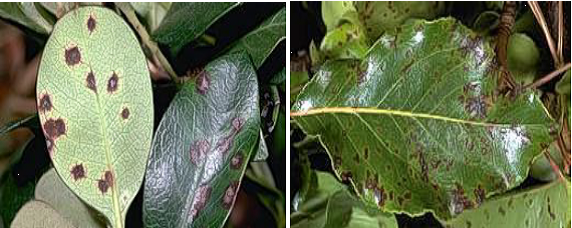
Survival and spread
- The pathogen is seed borne fungus and inoculums present in the seeds are source of primary infection. Fungus also survives on fruit and plant debris.
Favourable conditions
- The disease is favoured by temperatures between 77 and 86 °F (25–30 °C), and by wet conditions.
- Infection occurs at optimum temperatures with 5.5 hours of wetting and an outbreak can become serious within two days of infection.
Fire Blight
Disease symptoms
- Branch and trunk canker symptoms can appear as soon as trees begin active growth.
- The first sign is a watery, light tan bacterial ooze that exudes from cankers (small to large areas of dead bark that the pathogen killed during previous seasons) on branches, twigs, or trunks.
- The ooze turns dark after exposure to air, leaving streaks on branches or trunks.
- However, most cankers are small and inconspicuous; thus infections might not be noticed until later in spring when flowers, shoots, and/or young fruit shrivel and blacken.
- The amount of fruit loss depends upon the extent and severity of the disease.
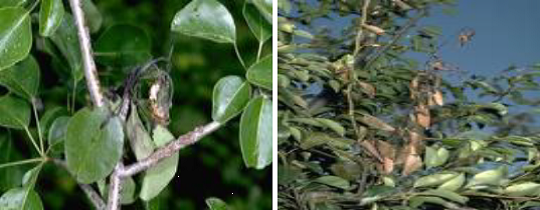
Survival and spread
- Splashing rain or insects transmit the bacteria to nearby blossoms or succulent growing shoots.
- Once blossoms are contaminated with the bacteria, honey bees become efficient carriers of the pathogen.
Favourable conditions
- Spread of the pathogen are rainy or humid weather with day time temperatures from 75° to 85°F, especially when night temperatures stay above 55°F.
Scab
Disease symptoms
- Olive green to black, circular, scabby or velvety spots appear on infected leaves, which may yellow or redden and drop prematurely.
- Scabby spots, often more sunken, may appear on fruit, which may crack or shrivel and drop.
- Shoots may die back if the disease is severe.
Survival and spread
- The pathogen survives through perithecia in the soil debris.
Favourable conditions
- Suitable temperatures and moisture promote the release of V. inaequalis ascospores.
- This cycle of secondary infections continues throughout the summer, until the leaves and fruit fall from the treeat the onset of winter.
Disease Cycle
Shoot fruit blight and bark canker
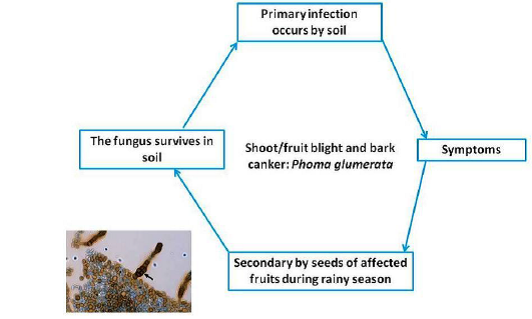
Crown rot

Root rot /white rot
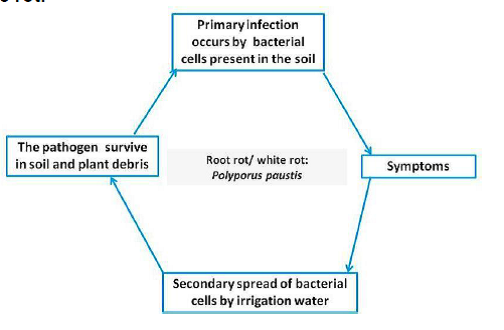
Collar rot
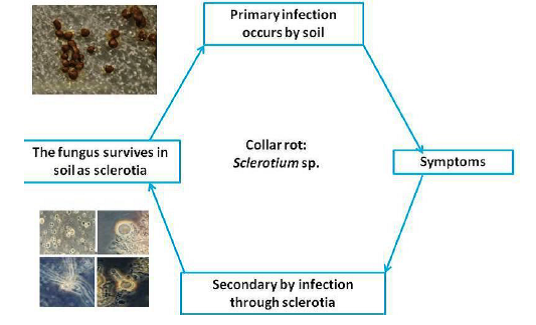
IPM for Loquat
To know the IPM practices for Loquat, click here.
Source:NIPHM; Directorate of Plant Protection, Quarantine & Storage
Last Modified : 4/1/2020
This topic provides information about Cherry: Dise...
This topic covers the Information related to Disea...
This topic provides information about Apricot-Desc...
This topic covers the Information related to Disea...
